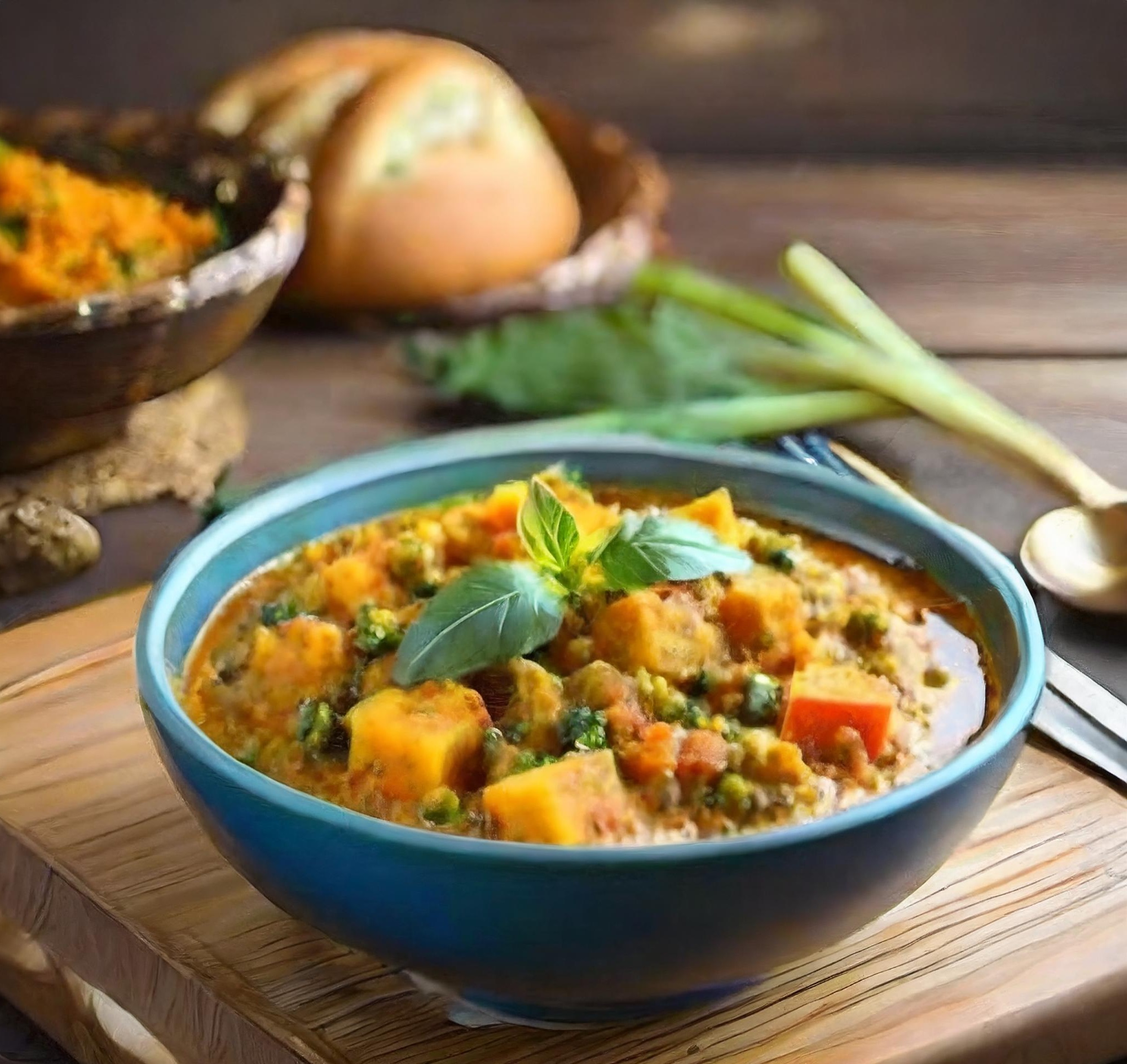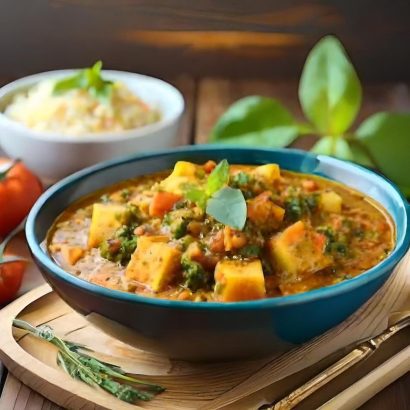Are you craving a burst of vibrant flavors and colors on your plate? Dive into this Mixed Vegetable Curry recipe, a harmonious blend of fresh veggies simmered in rich, aromatic spices that promises a feast for your senses in every bite.

This recipe is a colorful celebration of vegetables, each contributing its unique texture and taste, all enveloped in a mixture of spices that are the heartbeat of Pakistani kitchens. Picture a thick, savory sauce that clings to every piece of vegetable, offering a taste that’s both comforting and exotic. The main ingredients, ranging from potatoes and carrots to peas and bell peppers, ensure that every spoonful is a burst of nutrition and flavor. The curry’s aroma, rich with spices like turmeric, cumin, and coriander, will transport you to the bustling streets of Pakistan.
It’s a dish that promises to delight your palate and nourish your body, making every meal a celebration.
Ingredients used in mixed vegetable curry recipe
Here’s the ingredients you need to bring this Mixed Vegetable Curry recipe to life:
- 2 tablespoons vegetable oil – A neutral base that carries the flavors beautifully.
- 1 large onion, finely chopped – Adds a sweet, caramelized base to the curry.
- 2 cloves garlic, minced – Infuses the dish with a pungent, aromatic essence.
- 1-inch piece ginger, grated – Brings a warm, spicy undertone.
- 1 cup potatoes, cubed – Provides a hearty, comforting texture.
- 1 cup carrots, sliced – Adds sweetness and color to the curry.
- 1 cup bell peppers, chopped – Introduces a slight crunch and vibrancy.
- 1 cup peas – Offers a hint of sweetness and freshness.
- 1 can (14 oz) diced tomatoes – Gives the curry body and a tangy flavor.
- 1.5 teaspoons salt – Enhances all the flavors of the curry.
- 1 teaspoon turmeric powder – For color and its earthy flavor.
- 1 teaspoon ground cumin – Adds a warm, aromatic depth.
- 1 teaspoon ground coriander – Contributes a citrusy, slightly sweet flavor.
- 1/2 teaspoon chili powder – Adjust to taste for heat.
- 2 cups water or vegetable broth – The liquid base that brings the curry together.
- Fresh cilantro for garnish – Adds a burst of freshness and color.
Cooking Tools required for mixed vegetable curry recipe
To create this Mixed Vegetable Curry recipe, you need few cooking tools:
- Large skillet or sauté pan – Your primary cooking vessel, perfect for sautéing onions, garlic, and ginger, and simmering all the vegetables together.
- Cutting board and sharp knife – Essential for preparing your vegetables, ensuring they’re cut uniformly for even cooking.
- Measuring spoons and cups – Accuracy is key for balancing flavors, making these tools indispensable for measuring spices and liquid ingredients.
- Wooden spoon or spatula – Ideal for stirring your curry, ensuring nothing sticks to the bottom and the flavors meld beautifully.
- Blender or food processor (optional) – Handy if you prefer a smoother sauce or need to grind fresh spices.
How to make mixed vegetable curry recipe: Step by step process;
Follow these steps carefully to create an authentic Mixed Vegetable Curry recipe:
- Prep your vegetables: Wash and chop all your vegetables (potatoes, carrots, bell peppers, and peas) into bite-sized pieces. This ensures they cook evenly and absorb the spices well.
- Sauté the base: Heat the vegetable oil in a large skillet over medium heat. Add the chopped onion, garlic, and ginger, sautéing until the onion is translucent and the mixture is fragrant, about 5 minutes.
- Spice it up: Stir in the turmeric, ground cumin, ground coriander, and chili powder. Cook for another 2 minutes to let the spices release their flavors.
- Add the hard vegetables: Mix in the potatoes and carrots, coating them well with the spice mixture. Cook for about 5 minutes.
- Pour in tomatoes and liquid: Add the diced tomatoes and water or vegetable broth to the pan. Bring the mixture to a boil, then reduce the heat to simmer.
- Simmer away: Let the curry simmer uncovered for about 10 minutes, then add the bell peppers and peas. Continue to simmer until all the vegetables are tender, approximately 15-20 minutes, stirring occasionally.
- Adjust seasoning: Taste the curry and adjust the salt and chili powder according to your preference. If the curry is too thick, add a little more water to reach your desired consistency.
- Garnish and serve: Once the vegetables are cooked to perfection, remove the curry from the heat. Garnish with fresh cilantro before serving. Enjoy your Mixed Vegetable Curry with steamed rice or naan for a complete meal.
Expert Tip
Roast your spices before adding them to the curry. Take a small pan and dry roast the turmeric, ground cumin, coriander, and chili powder over low heat until they become fragrant. This process, known as “blooming,” intensifies the flavors of the spices, giving your curry a deeper, more authentic taste.
Roasting spices is a technique often overlooked in home kitchens but is a cornerstone in professional and traditional cooking. It enhances the natural oils and compounds in the spices, leading to a more robust and complex flavor profile in your dish. This simple yet impactful step can make the difference between a good dish and an unforgettable one, solving the common problem of curries that taste flat or one-dimensional. Try this technique, and you’ll notice how it brings a new depth of flavor to your curry, making it taste like it came straight from a Pakistani kitchen.
Serving Tips
To complement the rich and vibrant flavors of Mixed Vegetable Curry, consider pairing it with these delicious accompaniments:
- Steamed Basmati Rice: The fluffy grains make an ideal canvas for the curry, absorbing its flavors and adding a comforting texture.
- Naan Bread: Freshly baked naan, with its slight chewiness and char, is perfect for scooping up the curry and enjoying the full spectrum of its tastes.
- Raita: A cooling yogurt-based condiment seasoned with herbs and spices can balance the warmth of the curry, providing a refreshing contrast.
- Mango Chutney: The sweet and tangy flavors of mango chutney complement the spiciness of the curry, adding a delightful complexity.
- Green Salad: A simple green salad dressed with lemon juice and a pinch of salt offers a crisp, refreshing side that cleanses the palate.
Check more vegetarian recipes
Shaljam Gosht Recipe
Methi Chicken Recipe
Achari Aloo Ki Bhujia Recipe
Anda Bhuna Recipe
Storage Instructions
Ensuring your Mixed Vegetable Curry remains as delicious as when first made is simple with these straightforward steps:
To Store:
Allow the curry to cool to room temperature before transferring it into an airtight container. It can be stored in the refrigerator for up to 3-4 days, ensuring the flavors meld together even more beautifully over time.
To Reheat:
Opt for gentle reheating to preserve the vegetables’ texture and the curry’s flavor. Transfer the desired amount into a saucepan and reheat on the stove over low heat, adding a splash of water if necessary to adjust the consistency. Alternatively, you can reheat it in the microwave, stirring at intervals to ensure even warming.
Conclusion
In wrapping up my journey through the vibrant flavors of Pakistani cuisine with this Mixed Vegetable Curry, I’ve unlocked a treasure trove of tastes, textures, and colors. This recipe isn’t just about cooking; it’s about bringing a piece of culinary art to your table, a celebration of fresh ingredients and rich spices that promise to delight and nourish. Perfect for any day of the week, this curry stands as a testament to the joy of cooking and the pleasure of sharing good food with loved ones.

I’d love to hear how your Mixed Vegetable Curry turns out. Share your culinary creations with me and let’s celebrate the flavors of Pakistan together.
Frequently asked questions
What can I serve with mixed vegetable curry?
Serve with basmati rice, naan, or roti for a complete meal. A side of raita or salad complements the curry well.
Can I use frozen vegetables for the curry?
Yes, frozen vegetables are a convenient option and do not significantly affect the taste or nutritional value.
How can I make my curry more flavorful?
Toasting the spices before adding them to the curry can enhance their flavor. Using a good quality, fresh garam masala also makes a difference.
How long can I store the leftover curry?
Properly stored in an airtight container, the curry can last up to 3-4 days in the refrigerator.

Easy Mixed Vegetable Curry: A Taste of Pakistan in Your Kitchen
Ingredients
- 2 tablespoons vegetable oil - A neutral base that carries the flavors beautifully.
- 1 large onion finely chopped - Adds a sweet, caramelized base to the curry.
- 2 cloves garlic minced - Infuses the dish with a pungent, aromatic essence.
- 1- inch piece ginger grated - Brings a warm, spicy undertone.
- 1 cup potatoes cubed - Provides a hearty, comforting texture.
- 1 cup carrots sliced - Adds sweetness and color to the curry.
- 1 cup bell peppers chopped - Introduces a slight crunch and vibrancy.
- 1 cup peas - Offers a hint of sweetness and freshness.
- 1 can 14 oz diced tomatoes - Gives the curry body and a tangy flavor.
- 1.5 teaspoons salt - Enhances all the flavors of the curry.
- 1 teaspoon turmeric powder - For color and its earthy flavor.
- 1 teaspoon ground cumin - Adds a warm aromatic depth.
- 1 teaspoon ground coriander - Contributes a citrusy slightly sweet flavor.
- 1/2 teaspoon chili powder - Adjust to taste for heat.
- 2 cups water or vegetable broth - The liquid base that brings the curry together.
- Fresh cilantro for garnish - Adds a burst of freshness and color.
Instructions
- Prep your vegetables: Wash and chop all your vegetables (potatoes, carrots, bell peppers, and peas) into bite-sized pieces. This ensures they cook evenly and absorb the spices well.
- Sauté the base: Heat the vegetable oil in a large skillet over medium heat. Add the chopped onion, garlic, and ginger, sautéing until the onion is translucent and the mixture is fragrant, about 5 minutes.
- Spice it up: Stir in the turmeric, ground cumin, ground coriander, and chili powder. Cook for another 2 minutes to let the spices release their flavors.
- Add the hard vegetables: Mix in the potatoes and carrots, coating them well with the spice mixture. Cook for about 5 minutes.
- Pour in tomatoes and liquid: Add the diced tomatoes and water or vegetable broth to the pan. Bring the mixture to a boil, then reduce the heat to simmer.
- Simmer away: Let the curry simmer uncovered for about 10 minutes, then add the bell peppers and peas. Continue to simmer until all the vegetables are tender, approximately 15-20 minutes, stirring occasionally.
- Adjust seasoning: Taste the curry and adjust the salt and chili powder according to your preference. If the curry is too thick, add a little more water to reach your desired consistency.
- Garnish and serve: Once the vegetables are cooked to perfection, remove the curry from the heat. Garnish with fresh cilantro before serving. Enjoy your Mixed Vegetable Curry with steamed rice or naan for a complete meal.
Notes

Aleezay Khan
I am Aleezay Khan, I enjoy experimenting with flavors, giving traditional Pakistani dishes a modern twist. Join me on a tasty journey where classic meets contemporary, creating unforgettable food adventures.
